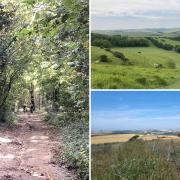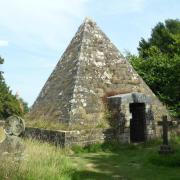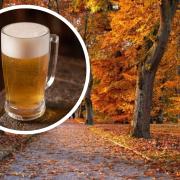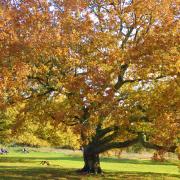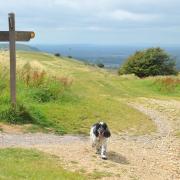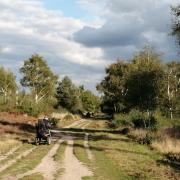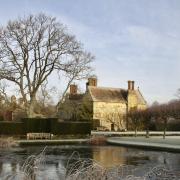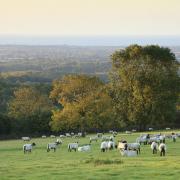Deirdre Huston’s walk on the greensand ridge at Iping and Stedham Commons includes heathland, ancient tumuli and an old farmstead
Lowland heathland
As you wander the gently rolling gradients, there's a struggle behind the serenity. Much heathland originated as common-land where villagers could graze their livestock and collect wood, bracken, gorse and heather for fuel and thatching. Over time the soil became depleted. Some species adapted to survive in these harsh conditions. Listen for the shrill echoing whistle of the woodlark, watch for the spiral display flight of the tree pipit from the tops of birch trees or skylarks showing the white rear edge of their wings when they fly.
Over the past couple of centuries more than 80 per cent of lowland heath has been lost from the UK but Iping and Stedham Commons is one of the finest examples of lowland heathland in Sussex. It is mainly owned by Sussex Wildlife Trust. The waft of Scots pine needles, a carpet of pink heather or strident yellow gorse may shout for attention but less obvious species depend on this habitat too. The dry sandy soil enables numerous insects to thrive so as you tread your way back to your car, think of the small creatures who may be out of sight but are so vital for our biodiversity: in spring, you may see mining bees, the common lizard or slow worm, or tiger beetles.
Mesolithic tumuli
Pause a while by the tumuli at the top of Trotton Common. These mounds of earth are bowl barrows and date from somewhere between the late Neolithic period to the late Bronze Age. These barrows may have covered single or multiple burials and are typical of patches of mounds found on the north side of the Downs, less noticeable but perhaps more prevalent than those on the Downland ridge. They may have been the focus for later rituals too but excavations of similar mounds have not always unearthed human remains. Whatever their purpose, somebody chose this prominent spot on the greensand ridge with care.
Where to refuel
A short hop in the car along the busy A272. Either turn right towards Midhurst and take the second left to Stedham where The Hamilton Arms offers snacks in the bar or Thai food in the restaurant. There is also outdoor seating.
Or turn left for Aylings Garden Centre where the indoor cafe has a terrace and freshly prepared food. Open 9am to 4.30pm or 3.30pm on Sundays. Pensioners deals on certain days. Dogs allowed outside.
Information
- Location: Iping and Stedham Commons Nature Reserve
- Distance: 3.2 miles (5.2 km) - An hour and a half
- Terrain: Soft footpaths and bridleways. Wellies advised if wet.
- Parking: Sussex Wildlife Trust car park. Sat nav: GU29 0PB to a crossroads on the A272. Turn towards Elsted and Harting.
- Map: OS Explorer 133
- Dog-friendly: Dogs must be on leads or under control.
The walk
1 Walk out through the car park entrance, cross the road and go through a small gate into the other side of the Sussex Wildlife Trust (SWT) reserve. Follow the signed bridleway straight ahead and glimpse distant tree-covered Downs to the right. Walk along this sandy mud track through gorse, heather, birch and Scott's pine trees. Pass a pine tree copse and fire beaters. At the marker post, continue straight on along this stretch of The Serpent Trail. Soon you will pass another marker post where you must also continue straight ahead. Go through a gate.
2 Turn right along Minsted Road, a single track lane with occasional traffic. Pass a SWT gate, and then two bridleway signposts in quick succession.
3 Turn right at the third signpost along a footpath and go through a SWT gate. This are is being treated for rhododendron disease so please read the signs. See the workings for the Sand Pit to your left. Continue up the path to the top where you may glimpse the water to your left through the pine trees. At the end, do not go through the gate but follow your path as it curves right through the heath.
4 Before you reach the gate leading onto the road, turn left and pass through a walkers' gate instead. Walk along a cone-strewn footpath lined with towering pines parallel to the road. At the wooden waymarker signpost, turn left along the signed bridleway. At the next wooden signpost continue straight ahead. The path climbs slowly then descends.
5 Turn right along a bridleway and past a signpost towards the fields. Walk between two posts and along beside the fence. This fenced path descends to an old farmstead. At the signpost in front of the buildings turn right.
6 At the marker post turn right away from the house again to walk along the bridleway and rough drive. Climb up this sunken path. At the marker post and signpost, continue on along this track as it curves left.
7 Cross the tarmac driveway to a gated house and continue straight ahead along the signed bridleway. This bordered path climbs and passes another signpost where you continue straight ahead. See a barn on your left and walk on down this hedged path which continues through a copse of slender birches. Go through a gate.
8 Cross the road and follow the signed bridleway right along a muddy farm track which starts to climb. Turn right at the marker post and T-junction with another dirt track and walk back up to the heath. Climb past mature pines, pass another marker post any gate. Head up towards the marker post near the top and you are rewarded with a vista over Iping Common. Don't turn here but continue a few steps further and pass some gorse.
9 Turn right at the marker post with a small Serpent Trail logo and walk through the gate to head diagonally right along the bridleway. At the next marker post, where the common opens out, is an ancient tumuli and there are two smaller mounds beyond. Turn right along the Serpent Trail to descend between the tumuli and the gorse. Walk on across the open heath. At the marker post keep left to walk past a pine tree and on through open heath. Pass another couple of marker posts signing the Serpent Trail and walk straight on along this track as it becomes more distinct. At the next marker post, join a track to walk straight on and back to the car park.
More…
- The best Sussex walks - With the South Downs, quaint villages and coastal trails, Sussex is a great place for a walk. Here we round up some of the best




